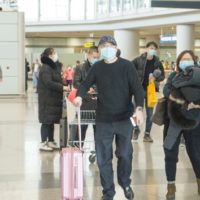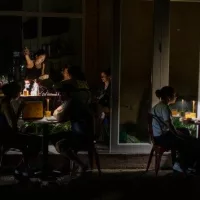
XiFotos/iStock(NEW YORK) — Frank Karinda was waiting for his wife to finish her doctor’s appointment when he decided to take his 1-year-old son for a walk around the hospital grounds in Filderstadt, Germany, a few weeks ago.
It was around the time fears of novel coronavirus were spreading, but Karinda thought nothing of it. Then he noticed, while his son waddled around and babbled about, a man was staring at his child.
“Then he basically said, in German … ‘He looks a little bit corona,'” Karinda told ABC News Thursday in a telephone interview. Karinda described himself as half Chinese and his wife as 100% Korean.
“Our baby looks fully Asian,” he said.
He said he was left “stunned” at the incident and went back to see his wife, Hawon Jung, who was so angry she took to Twitter to alert her followers that “coronavirus-related racism is real.”
“She thought it was really racist,” Karinda said. “Of course it’s racist.”
Natalia Molina, whose research includes the intersection of disease and race, said such instances are a double-edged sword: not only are they racist, but they also perpetuate unfounded information.
“The idea that this disease is mapped onto certain countries and not others is one key way in which we are going to hinder our ways of containing this disease,” Molina, who serves as a professor of American studies and ethnicity at University of Southern California’s Dornsife College of Letters, Arts and Science, told ABC News in a telephone interview.
She said we will keep seeing the spread of COVID-19 if people don’t take the time to properly understand it.
“We’re still more worried about someone looking Asian coughing into their shirt” than about understanding best practices to stop the spread, according to Molina.
Despite novel coronavirus spreading to every continent except Antarctica, it is Asians throughout the world who have been the subject of reported harassment and attacks.
There are currently more than 128,000 confirmed cases of the novel coronavirus around the world, according to a dataset provided by Johns Hopkins University.
The majority of the cases are on the mainland of China, where the disease was first detected in December. However, officials have said the epidemic appears to be subsiding there as the number of diagnosed cases shrinks each day.
Numbers elsewhere are on the rise, especially in Europe and the Middle East. Italy has reported the second-highest number of cases, with more than 12,400.
Iran and South Korea have reported the next highest number of confirmed cases at more than 10,000 and more than 7,800, respectively.
No official data is available on the number of attacks against Asians amid the outbreak. However, Dr. Jason Oliver Chang, an associate professor of history and Asian American studies at the University of Connecticut, has been tracking incidents he heard reported in the news since January.
Most recently, New York Gov. Andrew Cuomo announced Wednesday that the city’s Hate Crime Task Force was investigating a physical assault on an Asian woman in Manhattan that appeared to have been triggered “by the bigoted notion that an Asian person is more likely to carry or transmit the novel coronavirus.”
“To be clear, there is zero evidence that people of Asian descent bear any additional responsibility for the transmission of the coronavirus,” he added.
Other incidents included an attack on a student from Singapore in London, who said that a group of people beat him up and shouted, “I don’t want your coronavirus in my country,” according to The Guardian. Police were investigating and looking over CCTV footage to identify suspects, The Guardian reported.
The Anti-Defamation League and the National Council of Asian Pacific Americans, along with 258 other groups, urged lawmakers to address the “growing tide of racism directed at the Asian-American community” in a letter addressed to House Speaker Nancy Pelosi and House Minority Leader Kevin McCarthy.
“We urge House and Senate leadership to take tangible steps to counter the hysteria around the novel coronavirus, such as passing a joint resolution denouncing the racism, xenophobia, and misinformation surrounding it,” the letter reads.
Chang said aside from the daily harassment and attacks that have been reported, preexisting policies have also been harmful.
In Taiwan, officials complained that the self-ruled island is considered part of China by the World Health Organization and, in turn, lumped together with the country in terms of cases recorded.
Taiwan had reported exponentially fewer cases than mainland China, but a two-way travel ban was still put into place for the island by the Philippines in early February.
Chang said such a ban left many workers stranded in both the Philippines and Taiwan. The travel restrictions were lifted less than two weeks later. Taiwan has now reported 49 confirmed cases, whereas mainland China has reported more than 80,000, according to Johns Hopkins.
“It isn’t just anti-Asian because there are places within Asia where power politics are being played out,” Chang said. “It just kind of demonstrates to me that the COVID-19 pandemic is a stage in which people are playing out these existing conflicts.”
Molina said existing conflicts are also seen in the U.S., where she said “it doesn’t matter if you’re Chinese or Chinese American, we conflate Asian groups together.”
The country’s history of Chinese discrimination, including the Chinese Exclusion Act in 1882 that barred Chinese laborers from immigrating to the U.S., has played a role in the backlash Asian Americans may be experiencing.
“What’s frightening to me is that we have so much more scientific information today,” Molina said. “We have more of an understanding of this disease today and yet, it seems like there’s a purposeful entrenchment in racial stereotypes.”
She noted that those stereotypes had been amplified even by politicians, namely McCarthy, who this week received the letter from numerous organizations to combat racism.
McCarthy has referred to the disease as the “Chinese coronavirus,” prompting heavy criticism from some lawmakers and State Department officials.
Businesses in Asian communities, specifically in Chinatowns, have also suffered in the face of coronavirus and the anti-Chinese rhetoric that has followed.
In New York City, home to one of the largest Chinese communities outside of China, business owners have experienced an “unprecedented” decline, according to the executive director of the city’s Chinatown Partnership.
Businesses have reported seeing between a 30% to 70% drop in sales since February, around the time the first COVID-19 death was reported in the U.S., according to Wellington Z. Chen, the agency’s executive director.
“There are two major viruses going on: one is the coronavirus itself and then there’s the second, what they call an ugly cousin, that is causing more harm than the actual disease,” Chen told ABC News, referring to fear-mongering and anti-Chinese sentiment.
“They are afraid to come in for a haircut. They are afraid to go to the dentist,” he said. “We have seen a steady decline and [businesses] are telling me it’s a like bloodbath.”
Local politicians, like New York City Mayor Bill de Blasio, have shown support for the city’s Chinatown by visiting the area.
In San Francisco’s Chinatown, considered the oldest and largest outside of Asia, hundreds marched through the area to protest racism amid the disease.
“Fight the Virus — Not the People!” one banner read, according to San Francisco ABC station KGO-TV.
Gary McDonogh and Debbie Wong, a husband and wife who have conducted research on Chinatowns throughout the world, said the staggering numbers out of New York are similar to ones reported around the world, including in Seattle, Philadelphia and Sydney.
McDonogh said the decline is in part due to fear-mongering, but also a result of officials looking to place blame.
“When [President Donald] Trump was talking the other day and said, ‘America is not at fault,’ the question of trying to find someone at fault for a pandemic is a fundamental problem because it means we’re gonna blame anyone,” he said. “You can look for causes and cures, but you can’t start looking for blame.”
Amid the blame, anything associated with the disease will be attacked, according to Wong.
“It’s not about making careful distinctions. You lump everything Chinese together,” she said. “Everybody will be afraid of everything in weird ways. Everything is suspicious.”
Copyright © 2020, ABC Audio. All rights reserved.















